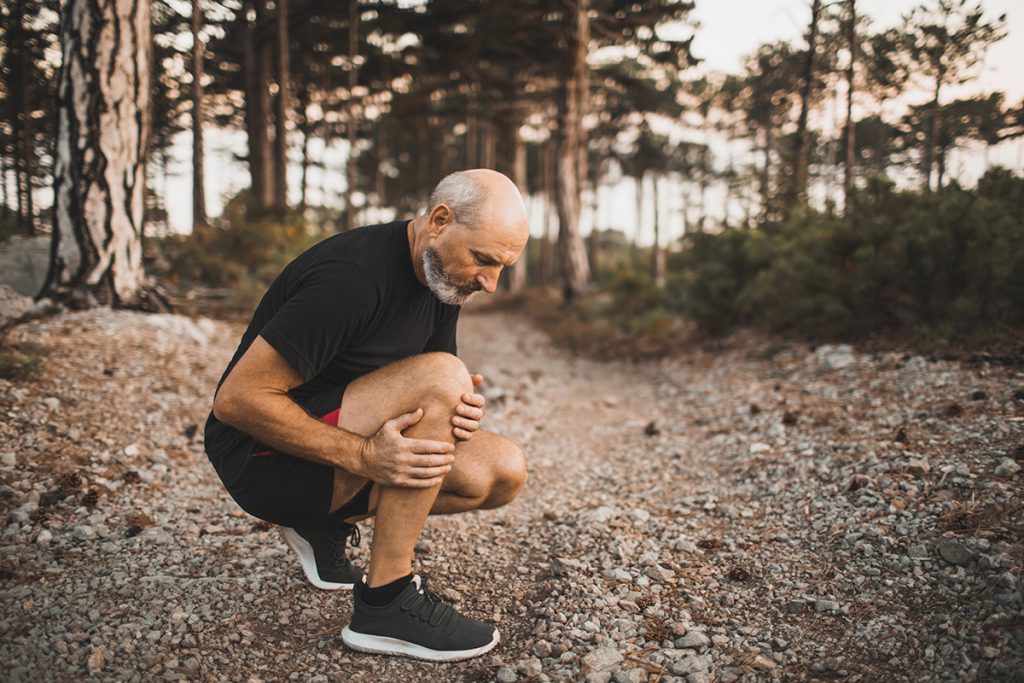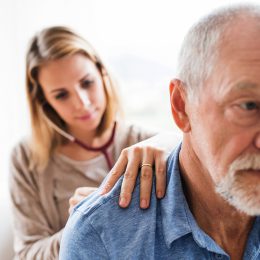Knee Pain Causes and Treatments: The SilverSneakers Guide
Stiff, achy knees are common among older adults. Understanding the root causes and treatment options is the first step toward relief. Start here.

Your knees are called to action countless times a day. Need to answer the front door? Your knees help power you forward. Picking up or moving a package? A bend of the knees is a crucial part of the motion.
When all is well with your knees, you don’t need to give them a thought. But add any amount of ache to the equation and it’s clear — knee pain is a major disruptor to your daily routines and quality of life.
Even a small reduction in your daily movement can have a ripple effect for your overall health, according to the Centers for Disease Control and Prevention.
Becoming more sedentary can set you up for a range of health problems, including weight gain and poor sleep, notes the CDC. Lack of physical activity has also been linked to an increased risk of heart disease, type 2 diabetes, and cognitive issues.
That’s why addressing any knee pain is about far more than just the knees themselves. Here’s your guide to what might be causing your knee pain, and how to treat and manage your symptoms.
Get and stay fit with SilverSneakers! Choose from dozens of different Community classes, visit a participating fitness location, or view the current schedule of SilverSneakers LIVE online classes. Check your eligibility here.
What’s the difference between acute and chronic knee pain?
When assessing knee pain and its possible causes, it’s helpful to first figure out whether you’re dealing with acute or chronic pain.
Acute pain comes on suddenly. It is usually sharp, with a specific known cause, such as a recent injury — for example, a torn ACL (anterior cruciate ligament), or a tendon rupture — or surgery.
If you banged a knee against the coffee table or landed on your knee after slipping on ice, for example, you know why your knee hurts. Acute pain can linger past the injury but usually resolves within six months, according to the Cleveland Clinic.
Chronic pain is tougher to pinpoint. It tends to last longer than six months and can come and go. Injury may still be the cause, but you might still feel pain well after the first damage occurred. You can also have chronic knee pain without any clear cause, the Cleveland Clinic reports.
This type of pain can be sharp, but it may also be a dull ache or make your knee feel unstable. You may also experience:
- Swelling
- Stiffness
- Weakness in and around your knee
- Popping or crunching noises when bending your knee
- Inability to fully straighten your knee
What can cause chronic knee pain?
The knee is a vulnerable joint that takes a lot of “wear and tear” stress from everyday activities like lifting and kneeling. High-impact exercise — such as jogging, jumping jacks, or other workouts where your feet leave the ground — also adds stress to your knees.
There are many possible causes for chronic knee pain. Some common ones include:
- Repetitive motion that puts stress on the knee
- Sprained or strained knee ligaments or muscles
- Torn cartilage
- Inflammation of the tendons, called tendinitis
- Arthritis, such as osteoarthritis or rheumatoid arthritis
- Weakened bone strength from osteoporosis, increasing the risk of fracture
- Bursitis, which is inflammation in the sacs of fluid cushioning the outside of the knee joint
- Piece of bone or cartilage that’s broken off due to injury or bone degeneration
- Dislocated kneecap
- Lack of muscle flexibility or strength
- Excess weight, which creates stress on knee joints
- Previous injury that has caused weakness in one or both knees
Knee pain may also occur as a result of injury to a different part of the body that affects how you walk. For example, hip pain may cause you to change your gait, which then puts more pressure on your knees, potentially stressing the muscles and tendons there.
When should you talk to your doctor about knee pain?
If you have a sudden and minor injury, such as banging your knee against a table, it’s likely you won’t need a doctor visit — only some ice and ibuprofen. But if there’s a more serious injury that causes pain to linger, or if your pain doesn’t have a specific cause, it’s important to consult your health care provider, according to both Johns Hopkins Medicine and the Mayo Clinic.
That’s particularly important if you’re having issues in other joints, such as your shoulders, hips, lower back, wrists, hands, and/or ankles. In that case, you may be dealing with arthritis, which requires a comprehensive treatment approach that goes beyond addressing just your knees.
You should call your doctor right away if:
- You’re unable to put any weight on your knee
- Your knee feels unstable
- You’re unable to fully extend or flex your knee
- You have a fever, swelling, or redness in addition to pain
Your health care provider will review your symptoms, list of current medications, and medical history. They will also examine your knee, pressing on it to see where it’s tender. They may also put your knee through some different range of motion tests to check the integrity of your tendons, ligaments, and menisci of the knee (this is the protective cartilage that cushions the joint surface and bone ends).
They may diagnose knee problems though imaging such as:
- X-ray
- Magnetic resonance imaging (MRI)
- Computed tomography scan (CT or CAT scan)
- Arthroscopy (a special illuminating instrument is inserted through a small incision)
- Radionuclide bone scan
Your doctor also may order blood tests to look for markers that indicate infection, diabetes, or diseases such as rheumatoid arthritis. And some symptoms may prompt them to draw fluid from your knee for closer analysis — for example, to check for gout.
What are the effects of ongoing knee pain?
The most significant danger of chronic knee pain is becoming more sedentary, says Theresa Marko, D.P.T., a board-certified orthopedic physical therapist who works with older adults.
Physical inactivity brings considerable health risks that layer on top of each other. For example, being sedentary might interfere with your sleep, which can then lead to trouble focusing on tasks and learning new things, according to the National Library of Medicine.
There are also emotional effects of chronic pain, reports the Cleveland Clinic. These can include depression, anger, and anxiety. You may also feel fear about the possibility of re-injuring your knee. That might limit your movement or keep you from activities you once enjoyed.
Addressing knee pain rather than just “sitting out” is essential, says Marko.
How is knee pain treated?
Depending on your symptoms and the underlying cause, a combination of lifestyle changes and simple medical strategies are the first-line treatments for knee pain.
This often includes:
- Topical gels and creams that reduce inflammation
- Pain relievers, such as ibuprofen
- Ice packs to reduce inflammation, particularly for acute pain and injury
- Compression bandage, which can help prevent fluid buildup in the knee while maintaining stability and alignment
- Injections, such as corticosteroids or hyaluronic acid, to ease pain and improve mobility
- Acupuncture, which has been shown to be a promising treatment for knee pain related to osteoarthritis
- A program to lose weight, if necessary
Talk with your doctor about what type of treatment might be right for you, particularly if your knee pain is ongoing. Your doctor may also recommend physical therapy to help strengthen the muscles around your knee to stabilize it, as well as exercises to improve range of motion.
How can exercise improve knee pain and function?
With knee pain, it’s common for people to avoid exercise in the belief that activity will worsen or prolong the pain, says Marko. But the opposite is true. Becoming more sedentary increases the chance of worsening your knee pain. When you don’t use the muscles around your knee, they become weaker, which puts more pressure on your knee joint.
That said, not all exercise is right when you have knee pain. Jumping, running, or other activities that create pressure on the knee are usually not recommended unless they’re supervised by a physical therapist.
But there are plenty of other activities that can help you strengthen the muscles around your knees. Consider trying these fitness options:
- Walking
- Strength training
- Gentle stretching
- Yoga
- Tai chi
- Swimming
Biking
Kayaking
Many SilverSneakers classes are low impact, so they can be helpful for improving your mobility while protecting your knees. You can also modify moves — or ask your SilverSneakers trainer for different options — if you find that certain movements worsen your knee pain.
One to try: SilverSneakers Classic. The exercises in this beginner-friendly class improve strength and endurance. It’s offered both in-person at participating fitness locations (check the gym for schedule details) and online with SilverSneakers LIVE.
Recommended reading:
5 Must-Know Exercise Modifications for Bad Knees
4 Exercises to Prevent Knee Pain
Press play to try simple strength exercises to help relieve and even prevent knee pain:
Subscribe to our newsletter
It's quick and easy. You could be one of the 13 million people who are eligible.
Already a member? Click to discover our 15,000+ participating locations.
Follow Us
What other lifestyle habits might make a difference with knee pain?
Exercise is a huge part of maintaining good joint health. But there are other lifestyle habits that can make a big difference — not just for your knees, but for all the joints in your body.
Maintain a healthy weight. Every extra pound puts additional strain on your knees and other joints, including your knees, reports Harvard Health. And extra weight increases your risk of osteoarthritis.
Eat foods that reduce inflammation. Nuts, seeds, fatty fish (like salmon), fruits, vegetables, beans, and olive oil help lower levels of inflammation throughout the body, which helps every system, including your achy knees.
Quit smoking. Research published in the Annals of Rheumatic Diseases shows that smoking can harm your joints, including your knees. Smoking can lead to greater cartilage loss and more pain if you develop osteoarthritis. Smoking also reduces blood flow, which can put you at greater risk for injuries like bursitis or tendonitis.
What are the surgical options for knee pain?
Unless you have a serious injury, it’s likely your doctor will recommend non-surgical treatments first. But if it’s determined that surgery is the best option for you, these are the different procedures your doctor will discuss with you:
Arthroscopic surgery. This involves repairing joint damage with just a few small incisions around the knee and the use of long, narrow tools.
Partial knee replacement surgery. In this procedure, your surgeon replaces only the most damaged part of your knee with parts made of metal and plastic.
Total knee replacement. Rather than repairing damaged parts of a knee, this procedure replaces the entire knee joint with an artificial one made of metal alloys, high-grade plastics and polymers.
Osteotomy. In this procedure, bone from the thighbone or shinbone is removed to better align the knee and relieve arthritis pain. In some cases, this surgery can help delay or avoid total knee replacement surgery, which tends to have a longer recovery timeframe.
Recommended reading:
Considering Joint Replacement Surgery? Why Older Adults Should Think Twice
New Knee? Here’s What to Expect from Your Recovery
As you address the root cause and find relief, you’ll be able to keep your activity levels and boost your overall health. It’s not always possible to get rid of chronic knee pain completely, but with proper treatment and regular activity, you can likely reduce its impact on your everyday life.
Our sources:
Sedentary effects: Centers for Disease Control. (2022) Physical Inactivity.
Acute vs. chronic pain/effects of chronic pain: Cleveland Clinic. (2020) Acute vs. Chronic Pain
Causes chronic knee pain/diagnosis: Johns Hopkins Medicine. (2022) Knee Pain and Problems and Mayo Clinic (2021) Knee pain
Exercising: Harvard Health. (2021) Take control of your knee pain and Penn Medicine (2018) Low Impact Exercises for Joint Pain
Treatments: Mayo Clinic (2021) Knee pain
Health effects of insomnia: National Library of Medicine. (2018) Insomnia
Cigarette smoking: Annals of Rheumatic Diseases (2007) Cigarette smoking and the risk for cartilage loss and knee pain in men with knee osteoarthritis
Take Your Favorite SilverSneakers Classes Online!
SilverSneakers members can access live fitness classes and wellness workshops through SilverSneakers LIVE. See the latest schedule and RSVP for classes here.
Not a member? If you have a Medicare Plan, it may include SilverSneakers — at no additional cost. Check your eligibility instantly here.
Not eligible for SilverSneakers? You can still get 200+ free SilverSneakers On-Demand videos and stay in touch with us by creating your online account.




